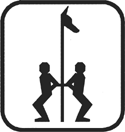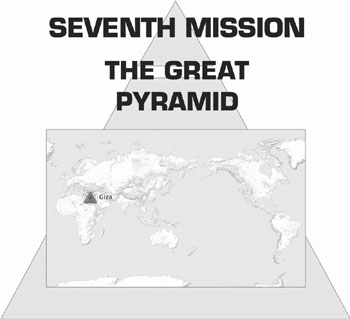Seven Ancient Wonders (47 page)
Read Seven Ancient Wonders Online
Authors: Matthew Reilly

Then it struck the uppermost tip of the obelisk—and the high needle of rock seemed to shine majestically—before the beam of sunlight slowly began to move down the obelisk.
The American force watched it in awe.
From his basket, Judah watched it in triumph.
From his position down in one of the Humvees, Wizard watched it in grim silence.
Then the sunlight struck the bore-hole on the existing obelisk
and shone directly through it. . .
. . . whence it continued on, shooting right into the pipe on Judah’s crane. . .
. . . and suddenly the great shaft of sunlight combined with the unnatural mist to become a tiny laser-like beam of multi-coloured sunlight.
The rainbow-coloured laser beam lanced out from the Temple, shooting in a dead-straight horizontal line
westward
, out across the Nile, out over the fields on the West Bank, out towards. . .
. . . the great bay of brown cliffs that protected and defended the Valley of the Kings.
No.
It was more precise than that.
The beam of light came to rest on the structure built
into
that bay of cliffs—a structure unique in all of Egyptian architecture, featuring two great rampways and three glorious colonnaded tiers.
Hatshepsut’s Mortuary Temple.
 | INSIDE HATSHEPSUT’S MORTUARY TEMPLE LUXOR, EGYPT 20 MARCH, 2006, 0630 HOURS THE DAY OF TARTARUS |
The Americans made swift progress.
The dazzling beam of sunlight had illuminated a lone archway at the far left of the lowest tier of the great structure.
There a door was found, so well-concealed that it appeared to be part of the wall itself. But above it was a familiar symbol that until today had been attributed little significance:

At the sight of the carving, Marshall Judah’s eyes shone with delight.
The Americans were through the door in no time.
Traps awaited them.
A passageway filled with vicious swing-traps—long swing-blades
that swooped out of slits in the ceiling and chopped one man’s head off.
Then a partially-submerged chamber, the knee-deep water of which concealed leg-chopping blades. Fortunately, from his research, Koenig knew the safe route.
Until Marshall Judah emerged from a stone doorway and stood on a platform that overlooked a gigantic subterranean cavern.
It wasn’t as big as the supercavern that contained the Hanging Gardens of Babylon, but what it lost in size, it made up for in artistry.
Every stone wall had been fashioned by human hands. There was not a single rough surface in the place.
It looked like an underground cathedral, with soaring high walls, a curved ceiling, and four immense sacred lakes arrayed in such a fashion that they created a wide raised path in the shape of a giant †. Great pillars of stone held up the superhigh ceiling.
At the junction of the †—the focal point of the great underground hall—was a raised square platform, flanked on all four corners by obelisks. On this high platform lay an ornate glass sarcophagus.
‘Ornate’ was barely sufficient to describe it.
It was crafted of gold and glass, and it lay underneath a high canopy crafted entirely of gold. The pillars of the canopy were not straight, but rather they rose in a bending, spiralling way, as if they were solidified vines.
‘The coffin of Alexander the Great. . . ’ Koenig breathed.
‘It was said to be made of glass,’ Wizard confirmed.
‘Wait a second. This looks familiar to me. . . ’ Judah breathed.
Beside him, Francisco del Piero—like the others, his hands were cuffed—bowed his head in silence, tried to be invisible.
Judah turned to Koenig.
‘Take some measurements with the laser surveying equipment.
I want to know the length, height and breadth of this hall.’
Koenig did so.
After a minute, he reported: ‘It is 192 metres long, and 160
metres wide at the widest point of the tee. Height of the cavern above the central junction is . . . 135 metres.’
Wizard snuffed a laugh.
Koenig turned. ‘What is so funny?’
‘Let me guess,’ Wizard said. ‘That canopy over the sarcophagus, the one with the twisted columns, it’s 29 metres high.’
Koenig did the computations with his laser surveying gear . . . and turned to Wizard in surprise. ‘It is 29 metres in height
exactly
. How could you know this?’
Wizard said, ‘Because this cavern has the exact same dimensions as St Peter’s Basilica in Rome.’
Judah swung to face del Piero, who shrank even lower, if that was at all possible.
Wizard went on, ‘If everything in the Roman Catholic Church is a reinvention of Egyptian Sun-worship, then why should St Peter’s be any different? Its dimensions are simply a replication of this sacred place: the resting place of the most prized Piece of the Capstone, the top Piece.’
They proceeded to the great altar at the focal point of the †-shaped hall, where they beheld the gold-and-glass coffin.
Through the glass, they saw only white powdery dust—the remains of the greatest warrior ever known, the man who had ordered the Pieces of the Capstone to be separated and scattered around the then-known world.
Alexander the Great.
A bronze Macedonian helmet and a lustrous silver sword rested upon the layer of white dust.
And sticking up from the middle of the dust-layer—as if it had once been laid upon the dead man’s chest, only to see that chest erode over the course of two millennia—was a tiny apex of gold.
A tip of a small golden pyramid.
The top Piece.
Without preamble, Judah ordered the coffin opened, and four of his men stepped forward, grabbed a corner each.
Del Piero started forward, ‘For pity’s sake, do take care!’
The men ignored him, removed the glass lid of the coffin roughly.
Judah stepped forward, and with everyone watching tensely, reached in, dipped his fingers into the remains of Alexander the Great, and pulled from them. . .
. . . the top Piece of the Golden Capstone.
Pyramidal in shape, with a base the size of a square paperback book, it radiated power.
More than that.
It radiated a power and an artistry and a
knowledge
beyond anything mankind had ever devised.
It was beyond man, beyond the limits of human knowledge.
The crystal in its peak glittered like a diamond. This crystal array bored down the spine of the gold mini-pyramid, reappearing at the base.
Judah gazed at it adoringly.
He now held in his possession
all seven
Pieces of the Golden Capstone, something no man had done since Alexander the Great.
He grinned.
‘It’s time to capture the power of Ra. Tartarus will arrive over Giza at noon. To Giza, and a thousand years of power.’

GIZA, EGYPT
20 MARCH, 2006
THE DAY OF TARTARUS
 | THE GREAT PYRAMID AT GIZA |
It is perhaps the only structure on Earth known by name to every single member of the human race.
The Great Pyramid.
The most common misconception about the Seven Ancient Wonders of the World is that the three pyramids at Giza comprise a single Wonder.
This is not the case.
While Khafre’s and Menkaure’s additional pyramids are certainly impressive monuments, only one pyramid is known as the
Great
one: that of Khufu (or Cheops, as the Greeks called him). It is this pyramid alone that comprises the Wonder.
In a word, it is breathtaking.
Its dimensions are staggering: 137 metres high, while each of its base sides is 140 metres long. With the addition of its missing Capstone—lost in antiquity—perfect symmetry would be returned and it would once again resume its original height of 140 metres and its intended shape.
It is estimated to weigh over 2 million tons, and yet, despite this unimaginable bulk, it contains within its mass the most intricate and beautiful passageways, all built with an exactness that defies belief.
It has outlasted pharaohs and kings, tribal wars and world wars, earthquakes and sandstorms.
Devotees of the Pyramid swear that it possesses unusual powers: it is said that no bacteria can grow inside the Great Pyramid. It is
said that flowers planted inside it grow with unusual vibrancy. It is claimed to heal sufferers of arthritis and cancer.
Whatever one’s beliefs, there is something about this man-made mountain that draws people to it, that entrances them. It defies time, it defies imagination. To this day, it is still not known exactly how it was built.
It is the only man-made structure in history to defy the ravages of Nature and Time, and indeed the only one of the Seven Ancient Wonders known to have survived to the present day.
It is a building without equal in all of the world.
 | THE GREAT PYRAMID GIZA (ON THE OUTSKIRTS OF CAIRO), EGYPT 20 MARCH, 2006, 1100 HOURS THE DAY OF TARTARUS |
The Great Pyramid of Khufu lorded over outer Cairo, absolutely dominating the landscape around it.